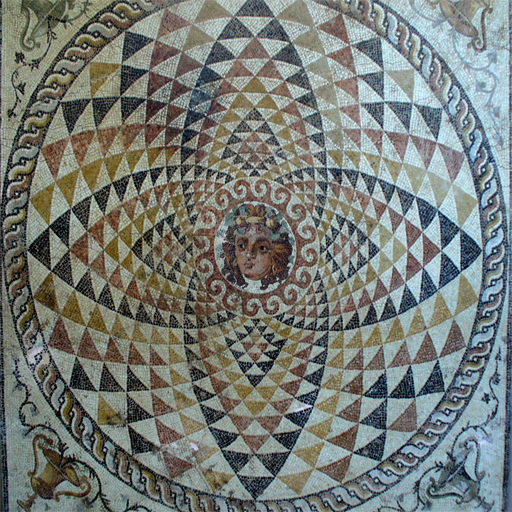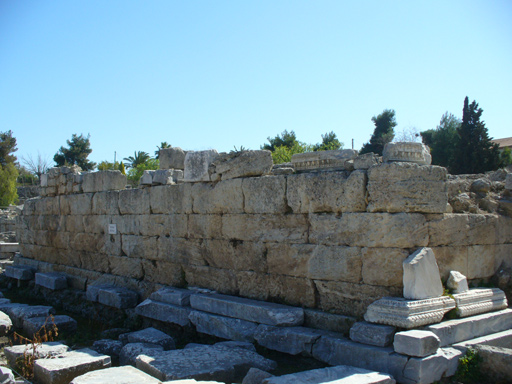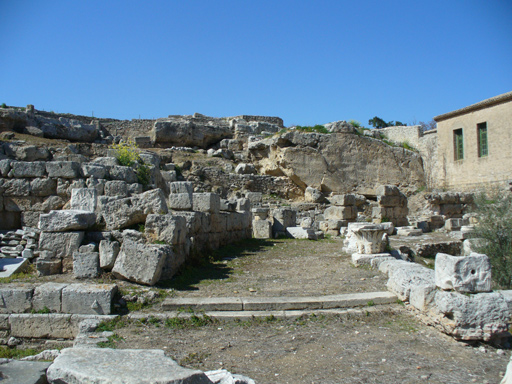HistoryCorinth is located in southern Greece about 50 miles from Athens, and about two miles south of the narrow isthmus that forms a land bridge between the main landmass of Greece and the Peloponnesus. Corinth controlled the two major harbors and thus commanded the trade routes between Asia and Rome. The city flourished from the 8th to the 5th centuries B.C. Because of the leading role it had played against them as a member of the Achaean League, the Romans burned and destroyed the city in 146 B.C., and left her a heap of ruins. All that remains of the old Greek city is a part of the old marketplace, the seven columns of the temple of Apollo, and a fountain which was preserved by the Romans. Julius Caeser rebuilt Corinth around 46-44 B.C. as a Roman colony and renamed it Colonia Laus Julia Corinthiensis, "Corinth the praise of Julius." It was this city that Paul saw in 50-51 AD. | Biblical SignificancePaul visted Corinth three times, the first time resulting in the establishment of the church there (Acts 18:1-18; 1 Cor.l5:l-2). Paul remained in Corinth for eighteen months and made his living as a leatherworker. Archaeology has illuminated numerous references to the Corinthians in both Acts and the letters of Paul. There are references to the synagogue at Corinth, the Christian church there, meat offered to idols, and athletic metaphors which may have been prompted by the Isthmian Games. It is in Corinth that an inscription referring to Erastus was found, only the second time the name of a person in the New Testament connected to the Christian movement was found by archaeology. In Romans 16:23 Paul mentions a city treasurer named Erastus. |
 On the drive from Athens to Corinth our first stop was at the canal across the isthmus. This canal was completed in 1893 and connects the Aegean Sea on the east with the Adriatic Sea on the west and is about 3.5 miles long, 75 feet wide at the top and 65 feet wide at the bottom.
On the drive from Athens to Corinth our first stop was at the canal across the isthmus. This canal was completed in 1893 and connects the Aegean Sea on the east with the Adriatic Sea on the west and is about 3.5 miles long, 75 feet wide at the top and 65 feet wide at the bottom.
Before this canal was dug, there was a roadway (diolkos) here to move cargo and small boats across this isthmus. It was built in the 6th century BC and used a movable wooden platform which ran across the roadway in grooves about four feet apart. Smaller vessels could be loaded onto this platform, but larger ships had to be unloaded first and their cargo transported across the isthmus while the ships and their crews made the hazardous voyage around the Peloponnesus.
 Our first stop in Ancient Corinth was at the ruins of a theater, dating back to the 5th c. BC. In Paul's time it seated about 14,000 spectators. Later it may have been used for gladiatorial battles and even possibly sea battles.
Our first stop in Ancient Corinth was at the ruins of a theater, dating back to the 5th c. BC. In Paul's time it seated about 14,000 spectators. Later it may have been used for gladiatorial battles and even possibly sea battles.
On the hill in the background is the Acrocorinth (high Corinth) where a temple for Aphrodite had been.

In 1929, among the excavated ruins of ancient Corinth was discovered an inscription on a marble paving stone bearing the name of Erastus.The inscription read: ERASTVS. PRO. AED. S. P. STRAVIT, which is an abbreviation of ERASTUS PRO AEDILITATE SUA PECUNIA STRAVIT. The inscription translates as "Erastus, in return for his aedileship, laid this pavement at his own expense." The office of aedilis was the commissioner of public works and, for this reason, a high ranking public offical belonging to the Roman ruling class in a city. Paul mentions an Erastus from Corinth in his Letter to the Romans (16:23) and identifies him as "the city treasurer" (oikonomos), which is not the Greek equivalent of the Latin aedilis; rather the oikonomos is equivalent to the lesser office of arcarius. If the Erastus of Rom 16:23 is to be identified with the man of the inscription, then he was aedilis either before or after Paul wrote his letter.
Our guide, Costas, pointed out that if this is accurate, it is an independent proof of Paul's knowledge of and presence in this area and is not dependent on church tradition.
 An overall view of the paved area near the theater to the left and the Erasmus inscription just below the center.
An overall view of the paved area near the theater to the left and the Erasmus inscription just below the center.
 Our first view of the higher level of the ruins. To the left we see the Fountain of Glauke, supplied with water from the Acrocorinth. In the center we get our first glimpse of the columns of the Temple of Apollo.
Our first view of the higher level of the ruins. To the left we see the Fountain of Glauke, supplied with water from the Acrocorinth. In the center we get our first glimpse of the columns of the Temple of Apollo.
 These three ornate Corinthian columns topped by a restored architrave are all that remain of the Temple of Octavia, the sister of the Emperor Augustus.
These three ornate Corinthian columns topped by a restored architrave are all that remain of the Temple of Octavia, the sister of the Emperor Augustus.
 We visited the museum where we saw Corinthian pottery, some sculptures and this 2nd c. mosaiac of Dionysius, the Greek god of wine.
We visited the museum where we saw Corinthian pottery, some sculptures and this 2nd c. mosaiac of Dionysius, the Greek god of wine.
 Here we see the Fountain of Glauke again. Four cisterns were hewn into this cubic monolith and filled by an aqueduct from the hills.
Here we see the Fountain of Glauke again. Four cisterns were hewn into this cubic monolith and filled by an aqueduct from the hills.
 The most striking structure of the ruins, the Temple of Apollo was one of the few buildings preserved by the Romans when they rebuilt the site in 46 BC.
The most striking structure of the ruins, the Temple of Apollo was one of the few buildings preserved by the Romans when they rebuilt the site in 46 BC.

The altars for sacrifice were in front of the temple. During great feast days so much meat was offered that the priests could not eat it all, so the surplus was offered for sale at a very reasonable price at the meat market. For some in the church this was a problem, as seen in the Biblical Significance page.
 The meat offered to idols may have been sold in a shop like the one pictured here at the edge of the Roman forum.
The meat offered to idols may have been sold in a shop like the one pictured here at the edge of the Roman forum.

A drawing of a reconstruction of Ancient Corinth about 100 AD. Number 1 is the Temple of Apollo, number 22 is the Temple of Octavia, Number 20 is the south stoa (porch), number 4 is the bema, number 14 is the southwest stoa.

A panoramic view of the agora.
 More of the agora.
More of the agora.
 A view of the bema, a raised place mounted by steps and used as
the official seat of a judge. This is the bema mentioned in Acts 18:12, "And when Gallio was the deputy of Achaia, the Jews made insurrection with one accord against Paul, and brought him to the judgment seat(bema)" The proconsul Gallio, however, judged that the teaching did not constitute an offence against the Roman law.
A view of the bema, a raised place mounted by steps and used as
the official seat of a judge. This is the bema mentioned in Acts 18:12, "And when Gallio was the deputy of Achaia, the Jews made insurrection with one accord against Paul, and brought him to the judgment seat(bema)" The proconsul Gallio, however, judged that the teaching did not constitute an offence against the Roman law.
It was here also that Costas reminded us of Romans 14:10: "for we shall all stand before the judgment seat(bema) of Christ." He also mentioned 2 Corinthians 5:10:"For we must all appear before the judgment seat(bema) of Christ."
 A pillar in front of the bema with a hole to which a person would be tied to receive the 39 lashes of Roman punishment.
A pillar in front of the bema with a hole to which a person would be tied to receive the 39 lashes of Roman punishment.
 This is the Fountain of Peirene, established during the Greek period, but not destroyed by the Romans in 146 BC. After a period of neglect between 146 B.C. and 44 B.C., the fountain was developed and renovated during a series of seven Roman periods.
This is the Fountain of Peirene, established during the Greek period, but not destroyed by the Romans in 146 BC. After a period of neglect between 146 B.C. and 44 B.C., the fountain was developed and renovated during a series of seven Roman periods.
 Another view of the Fountain of Peirene. Greek myth records the origin of this fountain as the result of the tears of Poseidon's lover Peirene when Artemis accidently killed her son Kenchrias.
Another view of the Fountain of Peirene. Greek myth records the origin of this fountain as the result of the tears of Poseidon's lover Peirene when Artemis accidently killed her son Kenchrias.
 The remains of the Lechaion Road, which leads from Corinth to the seaport of Lechaion.
The remains of the Lechaion Road, which leads from Corinth to the seaport of Lechaion.
 On both sides of the road were arcades with shops.
During the 5th century BC, the Corinthians build long walls, on both sides of the road, in order to protect the port.
On both sides of the road were arcades with shops.
During the 5th century BC, the Corinthians build long walls, on both sides of the road, in order to protect the port.
 Here are the remains of a large semicircular building. Costos suggested that the Jewish synagogue Paul visited may have been near here, perhaps under the modern building to the right,
Here are the remains of a large semicircular building. Costos suggested that the Jewish synagogue Paul visited may have been near here, perhaps under the modern building to the right,
 The odeion, a small theater used for musical event, held 3,000 spectators and was built by the Romans toward the end of the 1st century AD.
The odeion, a small theater used for musical event, held 3,000 spectators and was built by the Romans toward the end of the 1st century AD.
 A view from Ancient Corinth of the new city of Corinth and the Adriatic Sea.
A view from Ancient Corinth of the new city of Corinth and the Adriatic Sea.
Next we go to Mycenae.
